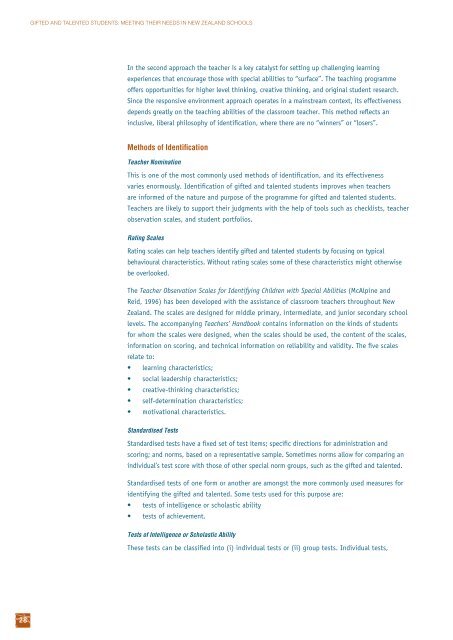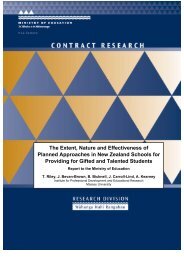GIFTED AND TALENTED STUDENTS: MEETING THEIR NEEDS IN NEW ZEALAND SCHOOLSIn the second approach the teacher is a key catalyst for sett<strong>in</strong>g up challeng<strong>in</strong>g learn<strong>in</strong>gexperiences that encourage those with special abilities to “surface”. The teach<strong>in</strong>g programmeoffers opportunities for higher level th<strong>in</strong>k<strong>in</strong>g, creative th<strong>in</strong>k<strong>in</strong>g, <strong>and</strong> orig<strong>in</strong>al student research.S<strong>in</strong>ce the responsive environment approach operates <strong>in</strong> a ma<strong>in</strong>stream context, its effectivenessdepends greatly on the teach<strong>in</strong>g abilities of the classroom teacher. This method reflects an<strong>in</strong>clusive, liberal philosophy of identification, where there are no “w<strong>in</strong>ners” or “losers”.Methods of Identifi cationTeacher Nom<strong>in</strong>ationThis is one of the most commonly used methods of identification, <strong>and</strong> its effectivenessvaries enormously. Identification of gifted <strong>and</strong> talented students improves when teachersare <strong>in</strong>formed of the nature <strong>and</strong> purpose of the programme for gifted <strong>and</strong> talented students.Teachers are likely to support their judgments with the help of tools such as checklists, teacherobservation scales, <strong>and</strong> student portfolios.Rat<strong>in</strong>g ScalesRat<strong>in</strong>g scales can help teachers identify gifted <strong>and</strong> talented students by focus<strong>in</strong>g on typicalbehavioural characteristics. Without rat<strong>in</strong>g scales some of these characteristics might otherwisebe overlooked.The Teacher Observation Scales for Identify<strong>in</strong>g Children with Special Abilities (McAlp<strong>in</strong>e <strong>and</strong>Reid, 1996) has been developed with the assistance of classroom teachers throughout <strong>New</strong>Zeal<strong>and</strong>. The scales are designed for middle primary, <strong>in</strong>termediate, <strong>and</strong> junior secondary schoollevels. The accompany<strong>in</strong>g Teachers’ H<strong>and</strong>book conta<strong>in</strong>s <strong>in</strong>formation on the k<strong>in</strong>ds of studentsfor whom the scales were designed, when the scales should be used, the content of the scales,<strong>in</strong>formation on scor<strong>in</strong>g, <strong>and</strong> technical <strong>in</strong>formation on reliability <strong>and</strong> validity. The five scalesrelate to:• learn<strong>in</strong>g characteristics;• social leadership characteristics;• creative-th<strong>in</strong>k<strong>in</strong>g characteristics;• self-determ<strong>in</strong>ation characteristics;• motivational characteristics.St<strong>and</strong>ardised TestsSt<strong>and</strong>ardised tests have a fixed set of test items; specific directions for adm<strong>in</strong>istration <strong>and</strong>scor<strong>in</strong>g; <strong>and</strong> norms, based on a representative sample. Sometimes norms allow for compar<strong>in</strong>g an<strong>in</strong>dividual’s test score with those of other special norm groups, such as the gifted <strong>and</strong> talented.St<strong>and</strong>ardised tests of one form or another are amongst the more commonly used measures foridentify<strong>in</strong>g the gifted <strong>and</strong> talented. Some tests used for this purpose are:• tests of <strong>in</strong>telligence or scholastic ability• tests of achievement.Tests of Intelligence or Scholastic AbilityThese tests can be classified <strong>in</strong>to (i) <strong>in</strong>dividual tests or (ii) group tests. Individual tests,28
PART ONE: DEFINITIONS, CHARACTERISTICS, AND IDENTIFICATIONsuch as the Stanford-B<strong>in</strong>et Intelligence Scale <strong>and</strong> the Wechsler Intelligence Scale for Children– Revised (WISC-R), are adm<strong>in</strong>istered orally by qualified psychologists. Subjects reply orally tomost questions. The WISC-R yields a verbal IQ, a performance IQ, <strong>and</strong> a student profile derivedfrom all the subtest scores. A full-scale IQ is also given.Group tests of scholastic ability, such as the Test of Scholastic Abilities (TOSCA), can beadm<strong>in</strong>istered by teachers. <strong>Students</strong> read the test items <strong>and</strong> write their answers. Group tests ofscholastic ability may be appropriate for <strong>in</strong>itial screen<strong>in</strong>g but are unsuitable for children withread<strong>in</strong>g difficulties <strong>and</strong> for some children from different ethnic groups.Tests of <strong>in</strong>telligence can also be classified as (i) verbal or (ii) non-verbal. The St<strong>and</strong>ardProgressive Matrices (with <strong>New</strong> Zeal<strong>and</strong> norms) is an example of a non-verbal test. It can beuseful for children from different cultural <strong>and</strong> ethnic groups <strong>and</strong> for children for whom English isa second language.Identificationshould never rely on<strong>in</strong>telligence testsalone, whether groupor <strong>in</strong>dividual, butshould <strong>in</strong>clude otherforms of evidence fromother methods.Identification should never rely on <strong>in</strong>telligence tests alone, whether group or <strong>in</strong>dividual, butshould <strong>in</strong>clude other forms of evidence from other methods.Tests of AchievementSt<strong>and</strong>ardised tests of achievement are sometimes used for <strong>in</strong>itial screen<strong>in</strong>g, particularly<strong>in</strong> <strong>in</strong>termediate <strong>and</strong> secondary schools. The <strong>New</strong> Zeal<strong>and</strong> Council for Educational Research(NZCER) series of Progressive Achievement Tests (PAT) <strong>in</strong> read<strong>in</strong>g, mathematics, <strong>and</strong> listen<strong>in</strong>gcomprehension can be useful for <strong>in</strong>itial screen<strong>in</strong>g.Most st<strong>and</strong>ardised achievement tests do not have enough items at the higher end of the scaleto challenge gifted <strong>and</strong> talented students. That is, they have too low a ceil<strong>in</strong>g. Furthermore,they emphasise convergent rather than divergent th<strong>in</strong>k<strong>in</strong>g.St<strong>and</strong>ardised tests have both advantages <strong>and</strong> disadvantages as <strong>in</strong>struments for identify<strong>in</strong>g thegifted <strong>and</strong> talented. Some of the advantages are high reliability, relatively high validity, <strong>and</strong> theexistence of national norms. They are also relatively <strong>in</strong>expensive (as group tests) <strong>and</strong> are usefulfor <strong>in</strong>itial screen<strong>in</strong>g. However, some st<strong>and</strong>ardised tests, such as the Torrance Tests of CreativeTh<strong>in</strong>k<strong>in</strong>g, lack validity, while others have a low ceil<strong>in</strong>g <strong>and</strong> a cultural, <strong>and</strong> gender bias. Somest<strong>and</strong>ardised tests are <strong>in</strong>appropriate for students with read<strong>in</strong>g <strong>and</strong> language difficulties.Teacher-made TestsSome teachers are well qualified to design tests of their own. Some of these tests can betargeted towards students with special abilities <strong>in</strong> specific curriculum areas. They may conta<strong>in</strong>a high percentage of items at the upper level of Bloom’s Taxonomy (see Curriculum Models,Part 2), as well as some open-ended <strong>and</strong> divergent-th<strong>in</strong>k<strong>in</strong>g items. Some teachers also developlocal norms.Portfolio AssessmentStudent portfolios are a useful form of assessment <strong>and</strong> can be helpful <strong>in</strong> identify<strong>in</strong>g gifted<strong>and</strong> talented students. They have the advantage of focus<strong>in</strong>g on the <strong>in</strong>dividual child’sperformance. Portfolios offer opportunities for examples of “best performance” <strong>and</strong> can showsystematic evidence of student achievement over time. They also allow for a rich variety of29
- Page 1 and 2: Gifted and Talented StudentsMeeting
- Page 3 and 4: GIFTED AND TALENTED STUDENTS: MEETI
- Page 5 and 6: ForewordGifted and Talented Student
- Page 7 and 8: INTRODUCTIONNew Zealand teachers ar
- Page 9 and 10: GETTING STARTEDMany schools have di
- Page 11 and 12: GETTING STARTEDtheir skills should
- Page 13 and 14: PART ONE: DEFINITIONS, CHARACTERIST
- Page 15 and 16: PART ONE: DEFINITIONS, CHARACTERIST
- Page 17 and 18: PART ONE: DEFINITIONS, CHARACTERIST
- Page 19 and 20: PART ONE: DEFINITIONS, CHARACTERIST
- Page 21 and 22: PART ONE: DEFINITIONS, CHARACTERIST
- Page 23 and 24: PART ONE: DEFINITIONS, CHARACTERIST
- Page 25 and 26: PART ONE: DEFINITIONS, CHARACTERIST
- Page 27: PART ONE: DEFINITIONS, CHARACTERIST
- Page 31 and 32: PART ONE: DEFINITIONS, CHARACTERIST
- Page 33 and 34: PART ONE: DEFINITIONS, CHARACTERIST
- Page 35 and 36: PART TWO: PROGRAMME DEVELOPMENT AND
- Page 37 and 38: PART TWO: PROGRAMME DEVELOPMENT AND
- Page 39 and 40: PART TWO: PROGRAMME DEVELOPMENT AND
- Page 41 and 42: PART TWO: PROGRAMME DEVELOPMENT AND
- Page 43 and 44: PART TWO: PROGRAMME DEVELOPMENT AND
- Page 45 and 46: PART TWO: PROGRAMME DEVELOPMENT AND
- Page 47 and 48: PART TWO: PROGRAMME DEVELOPMENT AND
- Page 49 and 50: PART TWO: PROGRAMME DEVELOPMENT AND
- Page 51 and 52: PART TWO: PROGRAMME DEVELOPMENT AND
- Page 53 and 54: PART TWO: PROGRAMME DEVELOPMENT AND
- Page 55 and 56: PART TWO: PROGRAMME DEVELOPMENT AND
- Page 57 and 58: PART TWO: PROGRAMME DEVELOPMENT AND
- Page 59 and 60: RECOMMENDED READINGSRecommended Rea
- Page 61 and 62: REFERENCESAdditional Recommended Re
- Page 63 and 64: REFERENCESHigh Ability StudiesThe o
- Page 65 and 66: REFERENCESKrathwohl, D. R., Bloom,
















